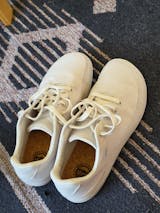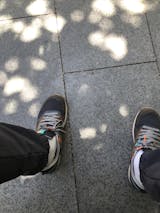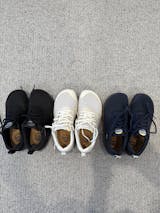The wet weather can really do a number on your footwear if they aren’t waterproof. In fact, water or moisture is one of the worst types of damage because it often leaves you with an irreparable and unusable pair of shoes! The good news, however, is that no matter what your shoes are made of, there are measures you can take to protect them from water and also keep them clean.
Some of the most common barefoot shoe materials like leather, suede, nylon, and canvas are not water resistant, however, they can be treated to prevent weakening and damaging of the material for when you get caught in the rain or accidentally step into a puddle. Waterproofing shoes is an excellent way to extend their lifespan while also protecting them from stubborn stains that otherwise penetrate the material.
So, if you’re looking for reliable ways to waterproof different types of shoe materials, you’ve come to the right place! Today, bprimal is sharing three simple guides to waterproof your favourite leather, suede, nylon, and canvas shoes. Take a look below!
How to Waterproof Leather Footwear
As durable as this material is, when leather encounters water, it extracts the oils that bind the material together which then causes the leather to become brittle as it dries up. It can also leave ugly water stains on the material that are difficult to remove.
Fortunately, it is rather simple to waterproof your leather shoes or boots; however, before you begin, you should keep the following information in mind.

Tips for Waterproofing Leather Footwear:
- Steer clear of lanolin and beeswax when choosing a leather waterproofing product as they diminish the suppleness of leather over time
- Choose an aerosol spray over pump sprays as it allows for a more even application
- When applying the waterproofer, do not stop midway as you might not get a uniform appearance if one part of the leather dries up earlier than the rest of the material
Steps to Waterproof Leather Shoes
Take out the laces and wipe the exterior of the shoe with a dry cloth. For stubborn dirt or scuff marks, use a slightly damp cloth and saddle soap to remove them. Once completely dry, use a leather polish to buff the material (use circular motions for best results). Any clean, soft cloth can be used for this. After polishing the leather, take another clean cloth and wipe over the material to remove excess polish (if any).Finally, when the polish dries, apply your chosen leather waterproofer to the shoes by following the instructions on the label of the product.
How to Waterproof Suede Footwear

Suede is no doubt a luxurious material to look at, as well as to touch. Unfortunately, it is prone to stains and damage caused by water or moisture. In fact, oftentimes, the appearance of a brand new pair of suede shoes can be ruined by sweat stains after the very first use. For this reason, it is advisable to condition and waterproof your suede shoes when they are new so that they retain their original look for a longer period of time.
Here’s how to do just that.
Steps to Waterproof Suede Shoes
Remove the laces and clean off dust and debris with a soft shoe brush or a clean microfibre cloth. If you are dealing with mud or mild stains, dampen a clean white cloth with a little bit of vodka and dab the area. If needed, gently rub the material in the direction of the fibres until the stain is removed. Once the material has dried completely, spray on the commercial suede conditioner and allow it to sit for 10 minutes or as recommended in the directions.In a well-ventilated room or outdoors, spray an even layer of the suede waterproofer over the entire upper material of the shoe. Allow it to dry for at least an hour before using or storing it away in a box.
How to Waterproof Nylon & Canvas Footwear

While these shoe materials can be cleaned with water or liquid-based cleaners, prolonged exposure to water or moisture weakens both nylon and canvas fibres. This is in addition to damaging or weakening the adhesive holding the shoe together. On top of this, shoes made of canvas or nylon are easily stained due to their fairly high level of absorbency; therefore, waterproofing your shoes will also repel stains that often lead to permanent marks on the material.
Although you can find commercial waterproofing sprays for these specific shoe materials, a great, long-lasting waterproofer for canvas and nylon comes in the form of beeswax. You can purchase a small amount of the wax from a hardware store or from an online retailer and follow the tips and instructions below to effectively waterproof your shoes.
Tips for Waterproofing Leather Footwear:
- Clean and dry the shoes thoroughly as any dust or debris on the surface will reduce the efficacy of the wax
- If dirt and stains are not removed, they will be locked in once coated with wax
- Use a colourless wax to prevent altering the shade of the original shoe colour
- If you choose a coloured wax, test it on an inconspicuous area to ensure that it matches the colour of the material
Steps to Waterproof Canvas & Nylon Shoes
When the shoe is clean and dry, take the bar of beeswax and rub it evenly over the shoe material. Use a back and forth motion and just enough pressure to get a visible layer of wax over the material. Double check the shoes for missed spots and try to even out the application as far as possible.Take a hairdryer and switch it to the hottest level; turn it on and wait for the temperature of the air to rise.While holding the hair appliance in close proximity to the shoe, apply heat all around the material to melt the beeswax. You will notice the wax starting to fade as it melts and penetrates the pores of the material; this is exactly what you want. After the wax melts and hardens again, the nylon or canvas will not look any different than it did before waterproofing it (other than a slight change in shade if you are using a coloured or off white wax). Check for wax that has not been melted and apply heat as needed. When a few hours have passed, test the waterproofed material with spoons of water and observe if any of the moisture soaks in; if this happens, wait for the shoe to dry and apply a second coat of wax by repeating the steps above.

Regardless of whether your barefoot shoes are water resistant or not, waterproofing them is a surefire way to keep them strong and looking their absolute best for years to come. Waterproofed leather, suede, nylon, and canvas shoes will not only prevent irreparable damage caused by water or moisture but also repel stains that often discolour the material and are near impossible to get out. The best and simplest way to waterproof different types of shoe materials is by purchasing commercial sprays that are specially-formulated for specific fabrics/materials. For best results, make sure that the barefoot leather shoe is properly cleaned, free of stains, and completely dry before waterproofing them using any one of the methods above.
Have fun & Enjoy your footwear!
At bprimal, we work with shoemakers and brands who create natural footwear that are made to encourage better foot health by repairing the damage caused by long term use of modern shoes. These minimalist or healthy footwear alternatives ensure proper preservation of one’s natural foot shape and function thanks to their inclusion of all the design specifics needed to achieve optimal foot health. Some of these features include wide toe boxes, slim and flexible soles, and no heel elevation. Our involvement and interaction with people who create and promote products that help individuals fix their foot problems has also inspired us to spread crucial awareness – relating to prioritising foot health as told by the experts – via our blog. Learn More - check out bprimal educational articles here, and browse through the different brands and collections of natural footwear and foot health restoration products we carry.
DISCLAIMER:
The above content is for educational or informational purposes only and is not intended to replace or augment professional medical instruction, diagnosis, or treatment. Read the full Terms and Conditions & Disclaimer here.























